Judging by the faces of the US team, only the Chinese win.other than the U.S. and Chinese
Sorry, I didn't mean to offend anyone.
Judging by the faces of the US team, only the Chinese win.other than the U.S. and Chinese
There is still hope for the U.S. in the long run as long as there is no ban in Chinese immigration depending on the future demographics of the country. Its a positive stereotype so I doubt anyone Asian is offended.Judging by the faces of the US team, only the Chinese win.other than the U.S. and Chinese
Sorry, I didn't mean to offend anyone.
They're historical account on the creations of the respective aircraft. might not be interesting for technical purpose.Colleagues, I apologize for the offtopic. Although the topic has long since departed from its name. I am not very familiar with the threads of this forum.
Prompt a stream of books.
I am intrigued by the books of David C. Aronstein
Have Blue and the F-117A: Evolution of the "Stealth Fighter"
and
Advanced Tactical Fighter to F-22 Raptor: Origins of the 21st Century Air Dominance Fighter
I am interested in the very history of the creation of these aircraft. I understand that the technical specifications are not there.They're historical account on the creations of the respective aircraft. might not be interesting for technical purpose.
The 2nd book however is bit more depth but it doesnt touch the RCS topics. The appendix contains rather generalized view on RCS's,
Then, those two are wonderful books. very well sourced.I am interested in the very history of the creation of these aircraft. I understand that the technical specifications are not there.They're historical account on the creations of the respective aircraft. might not be interesting for technical purpose.
The 2nd book however is bit more depth but it doesnt touch the RCS topics. The appendix contains rather generalized view on RCS's,
There detection range show as km in the photo so you can't say there is no number.
Lavrov's direct speech.Minister Sergei Lavrov , noting that domestic air defense missile defense systems were able to detect six American fifth-generation F-35 fighters near Iran's borders a few hours
Was it a "container", a radar station, or a local resident with binoculars - "This information still needs to be rechecked""в это время в воздухе на границе с воздушным пространством Ирана было минимум шесть F-35. Эта информация еще требует перепроверки, но подчеркивает всю нервозность ситуации"
"At that time, there were at least six F-35s in the air on the border with Iranian airspace. This information still needs to be rechecked, but underlines the entire nervousness of the situation."
I have found different sources saying 5,000 and different sources saying 10,000 objects. its able to classify UAVs, cruise missiles, passenger plains, tactical aircrafts etc based on HF, so if we were to pretend that it had a super shitty spatial resolution(high doubts on that) for example if we were to say the HF RCS value of a UAV would be 3m2, cruise missile, 7m2, F-35 13m2 passenger plane 30m2. The 26m2 and 39m2 readings would probably tell that 2-3 F-35s are close on that particular spatial resolutions etc, and if they decide to launch decoys for example that will just add little RCS value to the HF radar readings that something was launched. Sounds like it will have good target footprints with that many objects being monitored anyways.Was it a "container", a radar station, or a local resident with binoculars - "This information still needs to be rechecked"
That just some conspiracy BSHonestly, I don't understand what kind of monster it is. And what is its purpose. They say that this is generally a radar for the HAARP project.
It is also known that not all modules are installed, so it is difficult for me to determine the exact dimensions of the antenna.
What make you think the X-band and VHF band radar in my example have the same size or even the same range?Of course, I took with the same beam width and gain. How else?
Listen to yourself ...
You make an x-band radar so that its energetic characteristics coincide with the long-wave radar, you increase the gain by increasing the area. Thereby reducing the beam width.
Yes, you have created an x-band radar that has the same size, range, but very long scan times.
And now you say that this radar is better than the long-wave one. Than? The size is the same, the scan time of the standard 60 * 60 sector is 10 minutes instead of 10 seconds.
Don't you find it funny yourself?
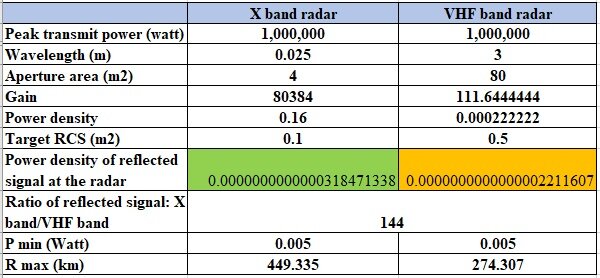
and there are counter intelligent. Nevertheless, I was replied to the claim that US F-22 operate in the same theater as Russia aircraft, therefore they must know its true RCS.Do you really believe that RCS values are obtained in close contact between two aircraft?
There is foreign policy intelligence for this.
Dismiss me from looking for a black cat in a black room. I'm not going to look for hidden meanings where there are none.
There will be numbers - there will be a conversation.
What you interested in is quite irrelevant, I just tell it like it is. That number a naked eye ball angle estimation from a guy when he suddenly realize that he was being attacked.I'm not very interested in your distortion of Zelko's words.
Show me in any of the simulations you have given before, is the air intake plugged?
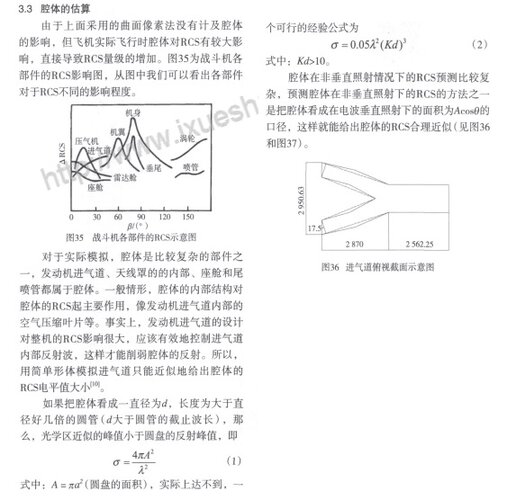
Trust is subjective. To what extent?Here's the fun part, but later.
Until then, answer the question.
Do you trust this article?

If you want to twist his comparison by comparing an ancient X-band radar to a very new L band radar then go ahead, I can't stop youThere detection range show as km in the photo so you can't say there is no number.
And what does this Figures tell you?
We don't know which radars he is comparing.
Okay, as an example.
The detection range of the S-125 of the F-117 aircraft is 26 km.
From the same document, we know that the RCS of F-117 is 0.2, both in centimeter and decimeter bands.
This corresponds to the Red zone in the screenshot.
And here is the decimeter "Protivnik-GE", for the same target with an RCS of 0.2. Range 400 km.
This corresponds to the Blue zone in the screenshot.
So you want to say that Wu Jian Qi proved with his screenshot that the RCS of the F-117 is 0.2?
I don't know the characteristics of SBX.That just some conspiracy BS
SBX is used for anti ballistic missile defense , the radar has about 45000 T/R modules
With the size, I exaggerated a little. But just a little bit. I don't know how you calculate ...What make you think the X-band and VHF band radar in my example have the same size or even the same range?
X band radar is 20 times smaller than the VHF band radar, and yet it can detect target from 60% longer range.
That why I said what you claimed about RCS doesn't make sense because X-band ended up having much longer detection range against stealth aircraft even with a smaller radar.
As I understand it, you did not read further ...The F-35 simulation I cite earlier did model the inlet

I am not discussing indirect signs.If that was the only data point, there were a serial of evidences that pretty much support the same conclusion
_ Various articles repeat the statement from USAF and LM
_ The comparison statement from Wallace the senior manager for F-35 flight operation and former chief of B-2 low observability
_ The detection range chart from Wu Jian Qi the chief engineer of CETC
_ Monograph by Major Michael F. Hake of US airforce
_ The slides from Lockheed Martin clearly showing the 5 fold reduction in detection range
_ Several radar scattering simulation showing frontal RCS between -10 to -20 dBsm even without the application of RAM and especially at the S-duct which have accumulate absorption effect.
This is what I want to tell you that indirect data can be juggled in different ways. Naturally, I do not know which radar station he took in his presentation. I just picked the ones that fit this picture.If you want to twist his comparison by comparing an ancient X-band radar to a very new L band radar then go ahead, I can't stop you
I don't know the characteristics of SBX.
Bring them in, and then we will discuss them. The range is clear, you need dimensions, range for a typical target, and the time it takes to view a sector.
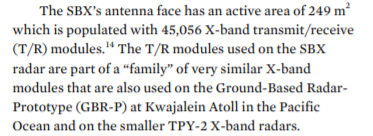
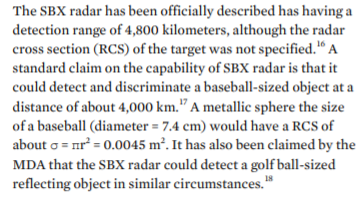
Firstly, 4 times bigger diameter will lead to about 16 times bigger antenna.With the size, I exaggerated a little. But just a little bit. I don't know how you calculate ...
Did you intentionally reduce the gain of the long-wave radar? If we assume that your radar is square, then the side length will be 9 meters, which for a wavelength of 3 m will give a beam width of 21-22 degrees. P-18 - 6 degrees, ТNEBO-M - 4 degrees.
Let me try, and you will correct.
There is a radar of a meter range, with the characteristics as I indicated above.
Beam width = 6 degrees
Wavelength = 1.1m
These are our constants.
Find the diameter = (65 * 1.1) / 6 = ~ 12m
Area = ~ 111.5 m2
Gain = (4 * PI * 111.5) / (1.1 ^ 2) = 1158.3 or 30.6 dB
Frequency = 272.5 MHz
The task is to find the level of the returned signal in front of the antenna.
Options.
Power 20 kW (73 dBm), Range 100 km, RCS of the target 5 m2
x = ((30.6 * 2) + 73 - (103.4 + 20 * LOG10 (272.5) + 40 * LOG10 (100) -10 * LOG10 (5))) = -90.8 dBm
A task. Create an x-band radar with the same distance of parameters, taking into account that the RCS of a typical target in the x-band is decreased by 5 times. Without increasing power.
That is, we should get the same signal level in front of the antenna (-90.8 dBm) by increasing the gain.
We take the same formula.
((Х * 2) + 73 - (103.4 + 20 * LOG10 (10000) + 40 * LOG10 (100) -10 * LOG10 (1))) = -90.8 dBm
X= 49.80 dB or 95500
Further, knowing the gain and wavelength, we find the area. According to the formula you gave above.
95500=(4п*x)/0.03^2
X = Area = 6.83 m
Diameter = 2,94
As you can see, we reduced the size of the antenna by only 4 times, judging by the diameter.
Let's calculate the size of the beam at our gain.
65*0,03/2,94 = 0,66 degrees
Longwave radar, scanned sector 60 * 60 in (3600 / (6 * 6)) * 0.02 = 2 seconds
X-band radar (3600 / (0.66 * 0.66)) * 0.02 = 165 seconds.
So which radar would you choose?
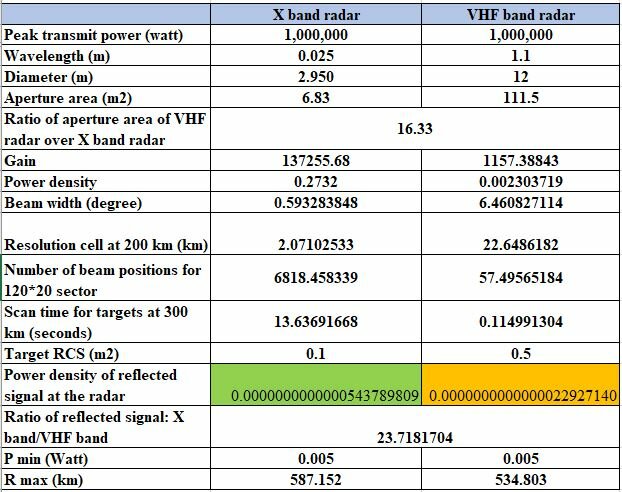
I told you earlier, I judge the scattering data not just on the graph value, but how they arrived at the number.As I understand it, you did not read further ...
On the same page.
View attachment 648357
Frontal RCS with calculated air intake is -1.48 dBm2 or 0.7 m2.
By the way, in the same document RCS F-22 is estimated at 0.1 m2. On page 5
That is, one more article, gave figures that you do not like?
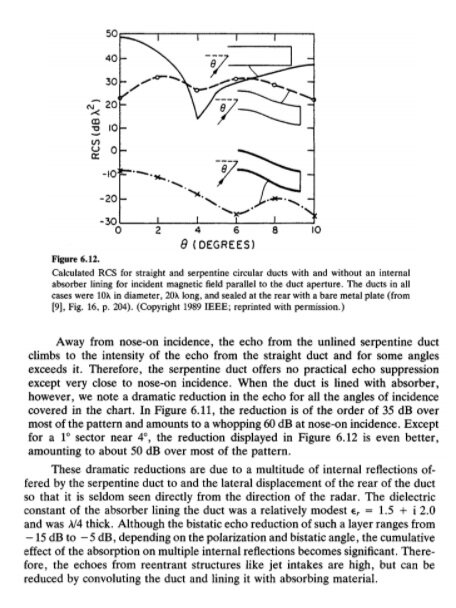
I am not discussing indirect signs.
These are questions of faith. And fortunately we are not at the church forum.
Good tracking radar. But not a surveillance radar.
Do you need such accuracy when reviewing a standard sector in 3 minutes? In 3 minutes they will release a bunch of "harms" at you, turn around and leave. And for another 3 minutes, your radar will not even see the "harm" that hit it.Secondly, I would still choose the X band radar, the scan time is longer than VHF one but it is 10 times more accurate and aperture area is 16 times smaller.
Can you bring other figures of similar object in different bands?But that not the point, the point is the alleged significant detection range advantage of VHF radar over X-band when used against stealth aircraft is no where to be found if RCS at VHF is only 5 times bigger than RCS at x band
Of course not. I cited an article by Taiwanese experts, just to show that such calculations are not very indicative. And the spread of numbers is very large. From 12 m2 to 0.7 m2.You must loved the Taiwanese F-22 scattering chart huh?sort of a "ha got you moment"?. Did it pissed you off when I pointed out the main reason for the huge frontal lobes is the two big flat plate they substitute for the inlet duct?

I am not forcing anyone to believe in these numbers. And it seems to me they are quite objective than the definition by indirect signs, such as pictures, pea-balls, and diagrams of radar stations unknown to us.it certainly take church like faith to believe Russia can have the exact RCS of F-22 before it even fully finished
Fortunately as we learn earlier, the massive advantage of S-duct is the ability to bounce radar signal multiple time before they got out.
So even a RAM layer with low absorption rating of 5 dB can be accumulated to over 60 dB, the more bounces the wave make before it get out, the higher absorption rate, and that for very slight curve duct, now imagine what the duct of F-22/35 can do when they can use RAM with higher absorption rating and can bounce radar wave many more times
I have an article someplace on one of my computers that discusses the blackjack having coatings on the compressor blades versus hiding them via the bones tactic of hiding them. I will try and locate it. I am not a coatings engineer to know if that's possible or not.Fortunately as we learn earlier, the massive advantage of S-duct is the ability to bounce radar signal multiple time before they got out.
Just like with the outside of the aircraft the shape of a cavity can be designed to reduce the signature. Inlet ducts are often designed with signature reduction through reflection as a goal.
That said, turbine faces look like bright strobe lights to some radars. The ducts prevent the poor radar from getting stuck staring straight into the strobes.
So even a RAM layer with low absorption rating of 5 dB can be accumulated to over 60 dB, the more bounces the wave make before it get out, the higher absorption rate, and that for very slight curve duct, now imagine what the duct of F-22/35 can do when they can use RAM with higher absorption rating and can bounce radar wave many more times
RAM with an "absorbtion rating" of 5 dB is not "low". There are physical and practical limits to what RAM can do, even over a narrow range of frequencies. Absorbing 20 db for a narrow range of frequencies on is pretty good (flat plate, normal to it). More than that and you are starting to run into the limits of what it is possible to absorb. There is no 100db RAM (and the physical limits are much, much closer to 20 than 100).
Ideally, when RF energy hits RAM in a cavity and "bounces" like you describe the signal is reduced by X (say, 5 db) each time. That means that the first hit is 5db less, then the second is 5db less of the signal that came out of the first "bounce". So the reduction does not accumulate as much as you seem to be describing.
In reality it is even less, as the RAM can become saturated with RF energy. It may not be able to absorb 5db on the 3rd bounce, etc.
I only cited SBX because you said no one would want a long range radar with long scanning timeGood tracking radar. But not a surveillance radar.
The baseball cheered up again.
120*20 sector is pretty standard for phased array radar, targets from 0 km- 18 km will be cover from distance of 50 km out to 400 km. Targets at altitude higher than 18 km and at closer range might need higher elevation but then for closer distance you can set a small section of the aperture to do quick short range scan.Do you need such accuracy when reviewing a standard sector in 3 minutes? In 3 minutes they will release a bunch of "harms" at you, turn around and leave. And for another 3 minutes, your radar will not even see the "harm" that hit it.
What do you mean?Can you bring other figures of similar object in different bands?
It is actually very indicative because you can see not only the value but also the lobes location. And if you pay attention on their 3D models, you will even know exactly why specific angle have strong reflection lobes and others doesn't.Of course not. I cited an article by Taiwanese experts, just to show that such calculations are not very indicative. And the spread of numbers is very large. From 12 m2 to 0.7 m2.
Also, if Taiwanese specialists counted as an air intake as a flat plane (as Knot does in their book), then the RCS would be 30-40 dBms, not 12 m2.
As they are not the manufacturer, the way they give an arbitrary number without showing the 3D model used to get the result (inlet S duct model or not?, RAM applied or not? what type?) and method of measurement (simulation or measurement? , VV or HH?) is questionable at best, for others third party simulation, whether it is Greece, China or Taiwan, the type of model they use and their simulation method is quite clear for analyzeI am not forcing anyone to believe in these numbers. And it seems to me they are quite objective than the definition by indirect signs, such as pictures, pea-balls, and diagrams of radar
rating of 5 dB is pretty mild for X-band range, and while there is no 100 dB RAM, the different between 20 dB and 5 dB is pretty massive, even more massive with multiple bounce.RAM with an "absorbtion rating" of 5 dB is not "low". There are physical and practical limits to what RAM can do, even over a narrow range of frequencies. Absorbing 20 db for a narrow range of frequencies on is pretty good (flat plate, normal to it). More than that and you are starting to run into the limits of what it is possible to absorb. There is no 100db RAM (and the physical limits are much, much closer to 20 than 100).
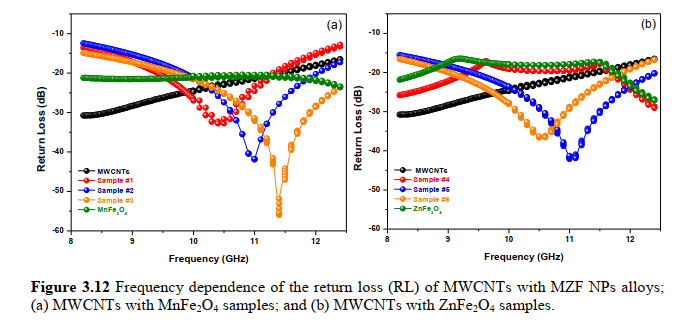
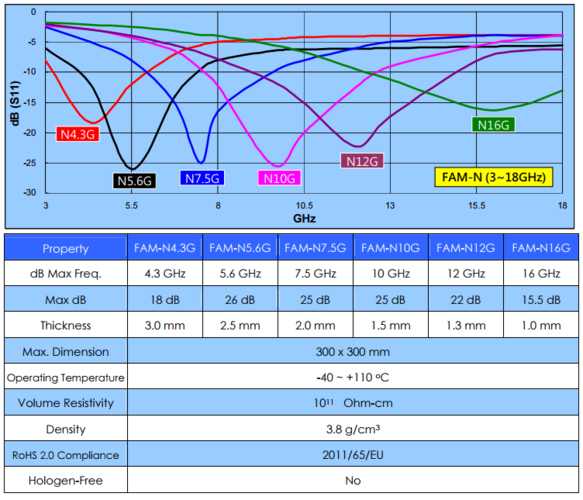
Yes you are correct, I just took the end result from knots, so may be the energy reduced that much because it bounces more times than I thoughtIdeally, when RF energy hits RAM in a cavity and "bounces" like you describe the signal is reduced by X (say, 5 db) each time. That means that the first hit is 5db less, then the second is 5db less of the signal that came out of the first "bounce". So the reduction does not accumulate as much as you seem to be describing.
I don't think you can over saturated the RAM with radar energy at beyond visual range.In reality it is even less, as the RAM can become saturated with RF energy. It may not be able to absorb 5db on the 3rd bounce, etc.
But you did not give the scan time.I only cited SBX because you said no one would want a long range radar with long scanning time
91Н6Е in static mode, scans sector 60 * 30 (1800) in 6 seconds for an instrumental range of 600 km.120*20 sector is pretty standard for phased array radar, targets from 0 km- 18 km will be cover from distance of 50 km out to 400 km. Targets at altitude higher than 18 km and at closer range might need higher elevation but then for closer distance you can set a small section of the aperture to do quick short range scan.
Didn't see 13 seconds in your messages.And you don't need 3 minutes, more like 13 seconds as calculated above.
It doesn't matter, It is important that the review time is longer than the rocket arrival time.Secondly, AESA and PESA have extremely weak and narrow sidelobes, so unless they are looking directly at you, then you can't detect it to launch HARMs.
Can you provide data on unobtrusive objects (Type F-117) in different ranges from radar manufacturers? For example from Northrop Grumman Electronic Systems or Raytheon.What do you mean?
It is significant that each article does not carry reliable information. Or partially reliable. Therefore, you cannot refer to them. I will write a little later about the air intakes, and about the TsAGI research.It is actually very indicative because you can see not only the value but also the lobes location. And if you pay attention on their 3D models, you will even know exactly why specific angle have strong reflection lobes and others doesn't.
Also, Taiwanese specialists did use as flat plate to cover the air inlet, as they clearly mentioned it in their study actually. The different with Knot book is due to the frequency used.
I gave all the main parameters of these data (frequency, radiation angle, etc.). Naturally, these figures are given taking into account everything. It makes no sense to analyze the capabilities of the modernized complex, hiding some factors. These are not just guys who are going to get a degree. These guys sell air defense systems, including to NATO countries, and to countries that participate in the F-35 program. And the lie would be revealed immediately.As they are not the manufacturer, the way they give an arbitrary number without showing the 3D model used to get the result (inlet S duct model or not?, RAM applied or not? what type?) and method of measurement (simulation or measurement? , VV or HH?) is questionable at best, for others third party simulation, whether it is Greece, China or Taiwan, the type of model they use and their simulation method is quite clear for analyze
Nothing prevents Chinese experts from adding RCS.Adding the “RCS” of individual components will not give you the RCS of the whole.
There isn't any detail about scan time. The scan time can be varied because it is a very big AESA radar so you could very well divide the aperture into smaller part for multi beam scanning.But you did not give the scan time.
Anyway ... SBX is a specific radar.
For example, I could not go to the x-range according to your data.
And you can't fool nature! Even if I take the antenna array pitch equal to the wavelength, completely destroying electronic scanning and violating antenna theory, then I get 74 mm. Let me remind you that the upper limit of the x-band is 37.5 mm.
Try to calculate you, maybe you will succeed.
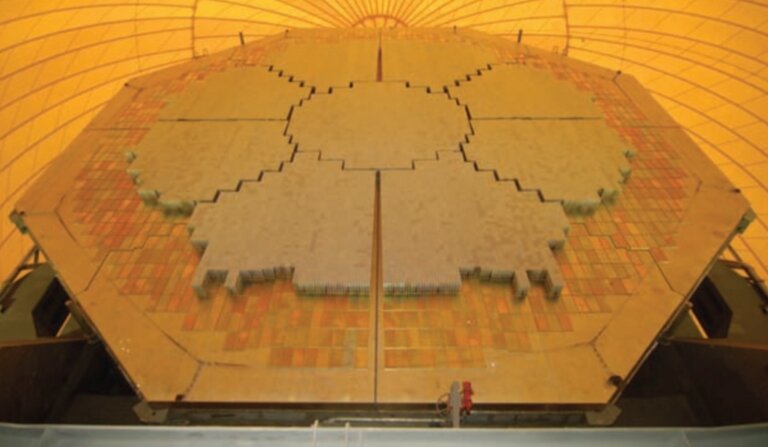
Look at my last image comparing VHF and X band, the scan time part.Didn't see 13 seconds in your messages.
Firstly, it isn't longer.It doesn't matter, It is important that the review time is longer than the rocket arrival time.
China and Russian only have stealth aircraft in production quite recently, so range data against F-117 type target isn't what USA radar manufacturer aim to advertiseCan you provide data on unobtrusive objects (Type F-117) in different ranges from radar manufacturers? For example from Northrop Grumman Electronic Systems or Raytheon.
The scattering characteristic of the shape is reliable, ofcourse these articles aren't perfect, but at least they are very open about their methodologies so it is very easy to identify the flawsIt is significant that each article does not carry reliable information. Or partially reliable. Therefore, you cannot refer to them. I will write a little later about the air intakes, and about the TsAGI research.
It not about whether they try to take into account everything, it just that there are information that would be impossible for them to know or acquire such as the type of RAM used. Or in case of the S-200 manual, they can't even know the exact external shape of F-22 yet because it isn't fully finished at that point, there was quite a lot of different between YF-22 and F-22. To analyze the internal hidden inlet duct is even more impossible.I gave all the main parameters of these data (frequency, radiation angle, etc.). Naturally, these figures are given taking into account everything. It makes no sense to analyze the capabilities of the modernized complex, hiding some factors. These are not just guys who are going to get a degree. These guys sell air defense systems, including to NATO countries, and to countries that participate in the F-35 program. And the lie would be revealed immediately.
Can you highlight for me, where does they say that in the S-200 manual or in the Ukraine study?For general development. Russian experts believe that the RAM on aircraft is used at the Crowley BX113 level. It is ideally suited for mechanical and other properties for aircraft.
It doesn't work like that, the amount of radar energy that an S-duct can absorb depend on the number of bounces that radar wave make before they hit the engine first stage and the number of bounce they make before they get out of the duct. Knots model a very slight curve duct, have you seen the duct of F-22 or F-35? They have very prominent curve that will let to many more radar bounce.We know that it is the air intake that makes the main contribution to the RCS from the front view. Chinese experts have estimated the S-shaped air intake at 75 m2. According to the Knot, the use of RAM will lower this value by 1000 times.
That is, the RCS of the F-35 air intakes can be estimated at 0.075 m2. This figure also agrees with the studies of the Russian TsAGI. One air intake of dimensions close to the existing ones, with RAM, at a wavelength of 3.2 cm, was estimated at 0.027 m2.
That is, two air intakes will amount to 0.054 m2.
With a high degree of confidence, it can be argued that S-shaped air intakes on modern aircraft contribute to the RCS of not less than 0.075-0.055 m2 or on average -12 dbsm.
Based on this, all sources that provide figures less than -12 dBsm can be considered unreliable.
We are not even talking about -20 dBsm , not to mention -30 dBsm or -40 dBsm.
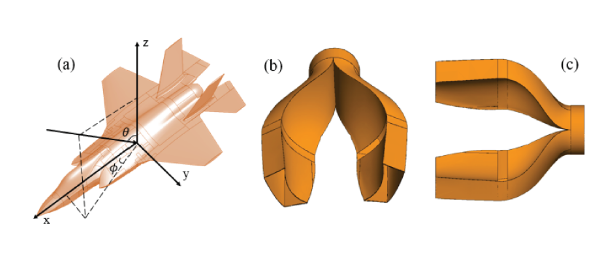
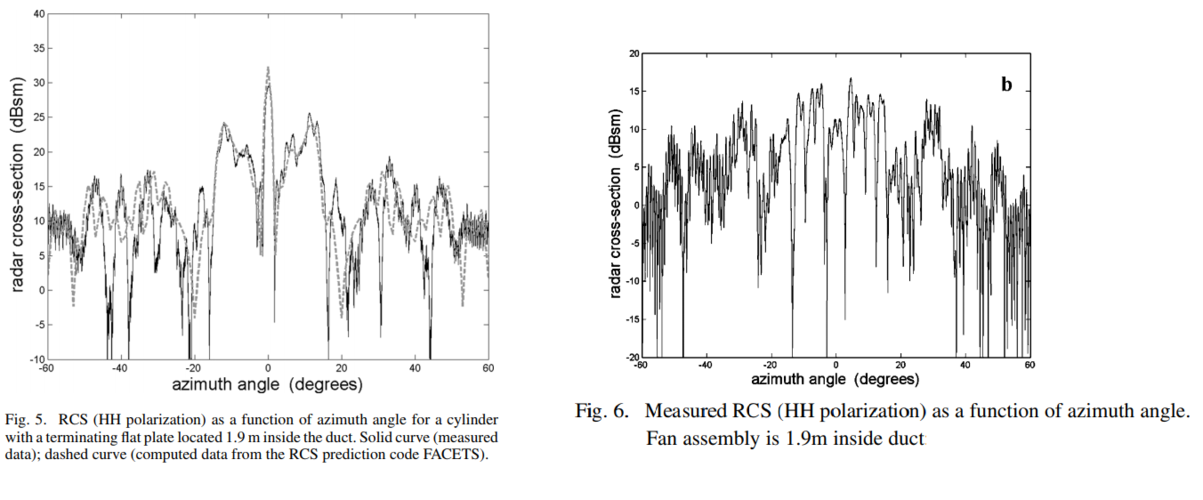
Then there is nothing to discuss.There isn't any detail about scan time.
What data you gave, such a calculation turned out.And you calculation is incorrect because the whole aperture isn't filled
I don't understand how you got this figure.Look at my last image comparing VHF and X band, the scan time part.
I do not know exactly how the harm works, but the inertial guidance system has been used on Russian missiles for a long time, if the radar is turned off. And it doesn't matter. Launch a rocket at the coordinates.Secondly, you pretty much won't detect the phased radar unless they looking at you because the side lobe is very weak, especially with things like Taylor 40 weighting. So before they looking at you, you wont be able to launch HARMs at them
If there is no data, then there is no point in talking further. So far, we have data from the Russian side. Will appear from the United States - we will compare.China and Russian only have stealth aircraft in production quite recently, so range data against F-117 type target isn't what USA radar manufacturer aim to advertise
How this data was obtained, alas, we will never know.It not about whether they try to take into account everything, it just that there are information that would be impossible for them to know or acquire such as the type of RAM used. Or in case of the S-200 manual, they can't even know the exact external shape of F-22 yet because it isn't fully finished at that point, there was quite a lot of different between YF-22 and F-22. To analyze the internal hidden inlet duct is even more impossible.
LM never mentioned these numbers. Therefore, it is difficult to find fault with them. I have already told you more than once, all the numbers with a small RCS, called the journalists. Likewise, researchers in their articles. But as we have already understood that the articles cannot be trusted.And Lockheed Martin also tried to sell their aircraft to many countries, apply the same logic as above, their lie would be revealed immediately
I have no data on the coverage you specified.And what is the absorbing rating, center frequency of Crowley BX113? How is it compare to Ironball on F-117 or Fibermat on F-35?
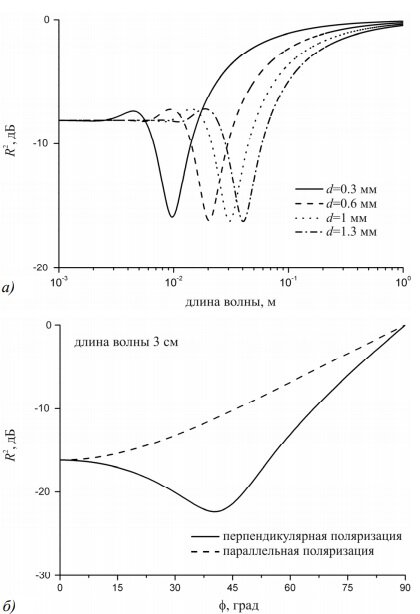
This is all clear. I also do not believe that these articles have a plausible result. As the others.It doesn't work like that, the amount of radar energy that an S-duct can absorb depend on the number of bounces that radar wave make before they hit the engine first stage and the number of bounce they make before they get out of the duct. Knots model a very slight curve duct, have you seen the duct of F-22 or F-35? They have very prominent curve that will let to many more radar bounce.
There are, your original point was basically that a big X-band radar won't be useful because it take too long to scan.Then there is nothing to discuss.
I thought you did research and know the aperture isn't fully filled? You even mentioned thatWhat data you gave, such a calculation turned out.
It in the number of pulse you send. 0.02 seconds in each beam position mean you send around 10 pulse down each position and the instrumental distance is about 300 km. But with massively powerful radar such as the one in our example, you can send fewer pulse down each beam position to reduce scan time.I don't understand how you got this figure.
Diameter = 3 meters
beam width = 65 * 0.025 / 3 = 0.541 in one plane or
0.541 ^ 2 = 0.3 square degrees.
Your sector is 120 * 20 = 2400 square degrees
2400 / 0.3 * 0.02 = 160 seconds
My sector, which a real radar passes through in 6 seconds.
60 * 30 = 1800
1800 / 0.3 * 0.02 = 120 seconds.
That is, your radar will scan this sector 20 times slower.
I think you misunderstood how anti radar missile work. Unless they are static radar and their position is known before hand, you need to detect/geolocate the radar with your RWR before you launch anti radar missile at them. Only after you geolocate their position then the INS guidance is helpful. For phased array radars, if they don't look at you you, then you won't detect them because their sidelobes are very weak.I do not know exactly how the harm works, but the inertial guidance system has been used on Russian missiles for a long time, if the radar is turned off. And it doesn't matter. Launch a rocket at the coordinates.
Given the circumstance, it just guess work.How this data was obtained, alas, we will never know.
They do mentioned the number, your choice of treating these balls, marble comparison as open to interpretation is just your choice.LM never mentioned these numbers. Therefore, it is difficult to find fault with them. I have already told you more than once, all the numbers with a small RCS, called the journalists. Likewise, researchers in their articles. But as we have already understood that the articles cannot be trusted.
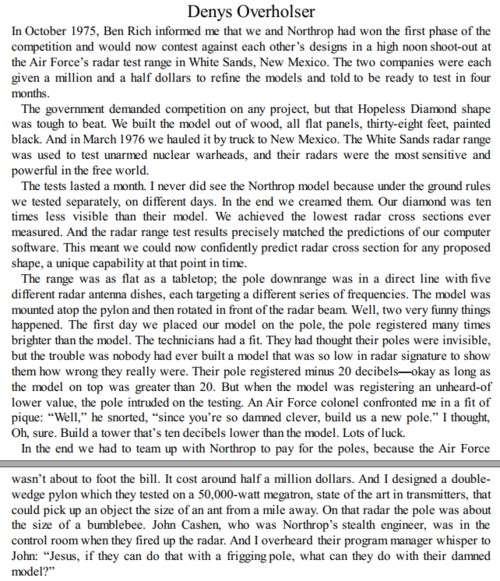
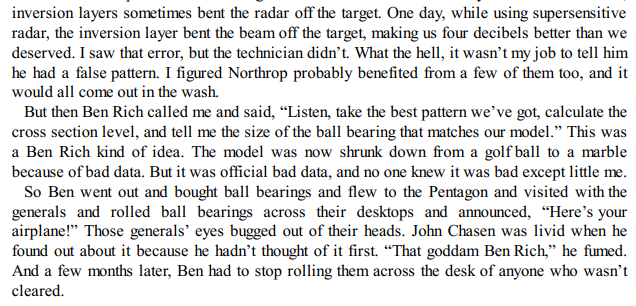
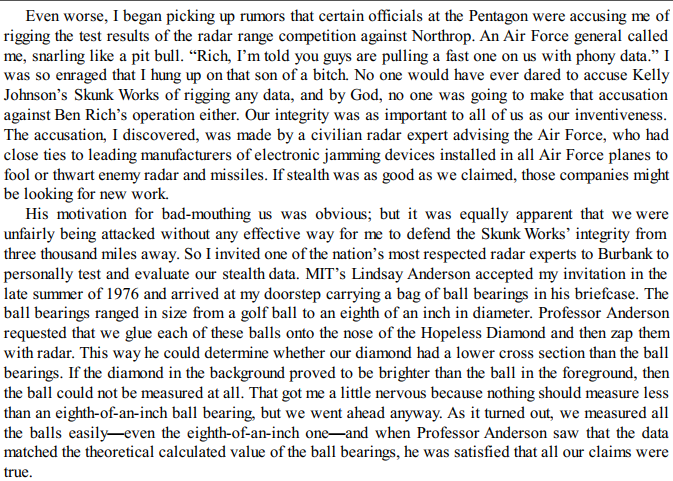
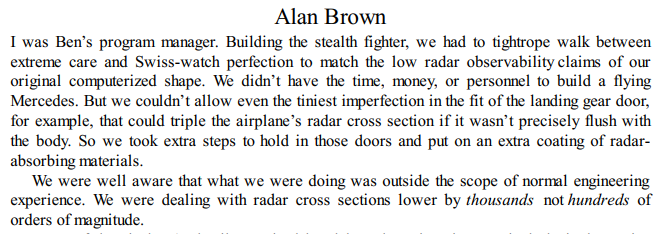
Firstly, can you show me the part in the S-200 manual or the Ukrainians study where they stated stealth aircraft use RAM similar to this?.I have no data on the coverage you specified.
If you have? Compare.
a) absorption from wavelength at different thicknesses.
b) reflection from the angle of incidence at a wavelength of 3 cm.
I will be grateful.
View attachment 648536
I explained before, this is the traditional way they used to give RCS of targets, by comparing its with metal ball of different size, because a ball have same RCS from all direction and easy to visualize.
If you read the book: "Skunk Works A personal Memoir of my years at Lockheed" written by Ben Rich the engineer and the second Director of Lockheed's Skunk Works, also known as the farther of stealth, you will see this "ball, marble comparison has some tradition"
When they wanted to test their full scale model, the RCS of the pole was too high, higher than the model itself and the RCS of the pole is only -20 dBsm
My point of view remains the same.There are, your original point was basically that a big X-band radar won't be useful because it take too long to scan.
I showed extremely big X-band radar.
That's what I say. This is not a wrong calculation, this is the data that you provided is not correct.I thought you did research and know the aperture isn't fully filled? You even mentioned that
0.02 is the acquisition time per beam offset. This parameter for modern radars varies from 0.04 to 0.01. I took averages of 0.02. Why did you lower this parameter in your calculation by an order of magnitude, I do not know. I suspect that you are just jaggling the data to please yourself. Can you provide a surveillance radar with such parameters? If not, then I do not return to this topic anymore. I told you everything about it.It in the number of pulse you send. 0.02 seconds in each beam position mean you send around 10 pulse down each position and the instrumental distance is about 300 km. But with massively powerful radar such as the one in our example, you can send fewer pulse down each beam position to reduce scan time.
The first serif will determine the direction. When approaching, I think there will be enough side petals. Typically they are 30 dB less than the main beam. But with your huge 50dB gain, even the sidelobes will be huge.I think you misunderstood how anti radar missile work. Unless they are static radar and their position is known before hand, you need to detect/geolocate the radar with your RWR before you launch anti radar missile at them. Only after you geolocate their position then the INS guidance is helpful. For phased array radars, if they don't look at you you, then you won't detect them because their sidelobes are very weak.
No one denied the assumption. And air defense systems continue to be sold.Given the circumstance, it just guess work.
But how does this all relate to reality? Yes, they tested the Hopeless Diamond model made of wood, which has never even flown, and is even different from the Have Blue. Yes, they have achieved a colossal reduction in EPR (by several orders of magnitude), but compared to what? With the bombers of the time. Yes, no doubt. And I will tell you even more, this is a very good result.They do mentioned the number, your choice of treating these balls, marble comparison as open to interpretation is just your choice.
Of course this is not from the air defense documents. In air defense, RAM are not needed, they need a ready-made figure. This is from the work of TsAGI (an institute that deals with aerodynamics and electrodynamics, including in the interests of the Ministry of Defense). To evaluate the S-shaped air intakes, they took this material.Firstly, can you show me the part in the S-200 manual or the Ukrainians study where they stated stealth aircraft use RAM similar to this?.
As we know from physics, there is no absolutely black body. Something is always reflected. RAM also reflects. The second graph shows reflection / absorption versus incidence angle. That is, the absorption is maximum when the wave is incident perpendicularly (parallel polarization is a broken line).Secondly, I can't read Russian but based on the very noticeable Brewster angle in the second chart, I want to clarify that the reflection based on angle of incident here is the amount of front face reflection (meaning the amount of reflection came from the radar wave that doesn't entered the RAM to be absorbed)
My point is simple: you basically said no one would want a big X-band because scan time is too long, so I showed you an X-band with massive apertureMy point of view remains the same.
For tracking objects - a good radar.
If you want to prove otherwise, just give the scan time.
How is my data not correct? I gave you the correct aperture area and correct number of T/R modules.That's what I say. This is not a wrong calculation, this is the data that you provided is not correct.
If you have other data, let's recalculate the parameters.
The acquisition per beam position depend on three factors:0.02 is the acquisition time per beam offset. This parameter for modern radars varies from 0.04 to 0.01. I took averages of 0.02. Why did you lower this parameter in your calculation by an order of magnitude, I do not know. I suspect that you are just jaggling the data to please yourself. Can you provide a surveillance radar with such parameters? If not, then I do not return to this topic anymore. I told you everything about it.
About 13 -20 seconds isn't really long scan time. For Taylor 40, the sidelobes is about 40 dB weaker than the main lobes, at long range, this energy will dissipate very quickly.The first serif will determine the direction. When approaching, I think there will be enough side petals. Typically they are 30 dB less than the main beam. But with your huge 50dB gain, even the sidelobes will be huge.
But that's not the point. The fact is that 100 km, the rocket will fly in 150 s, and you will find it too late.
And it doesn't even matter if it's an anti-radar missile. Air defense is not the goal itself. As a rule, air defense guards a static object (for example, an airfield).
In short, I don't need a radar with such a scan time!
But how does this all relate to reality? Yes, they tested the Hopeless Diamond model made of wood, which has never even flown, and is even different from the Have Blue.
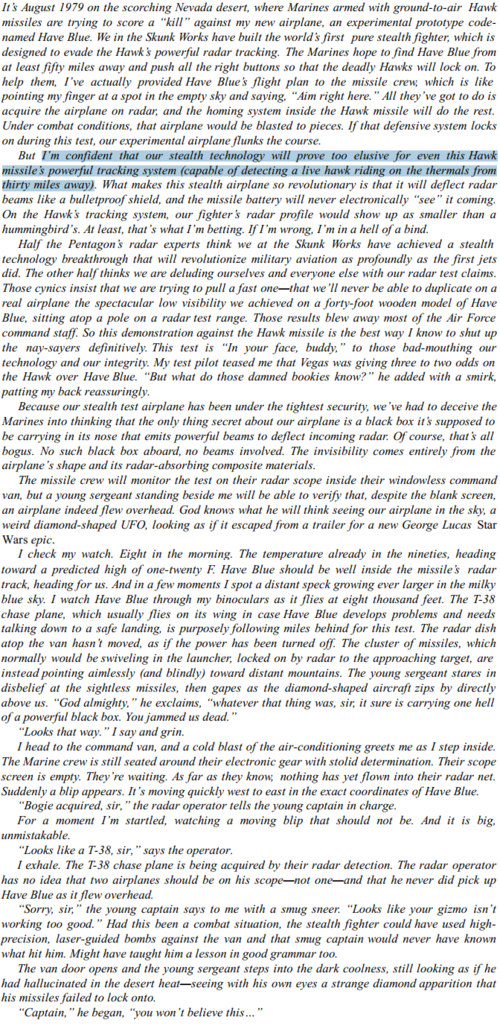
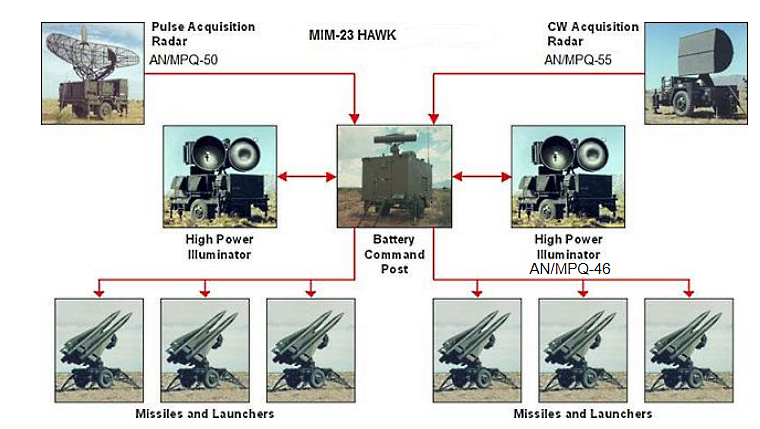

I know you would say thatYes, they have achieved a colossal reduction in EPR (by several orders of magnitude), but compared to what? With the bombers of the time. Yes, no doubt. And I will tell you even more, this is a very good result.
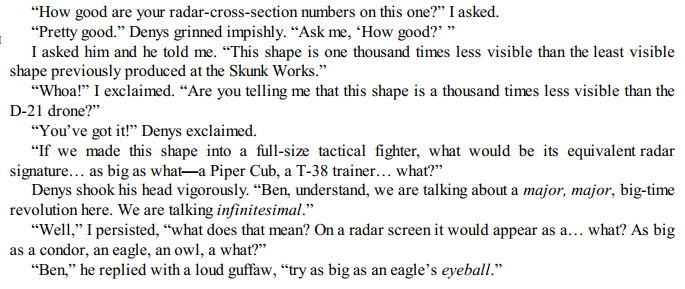

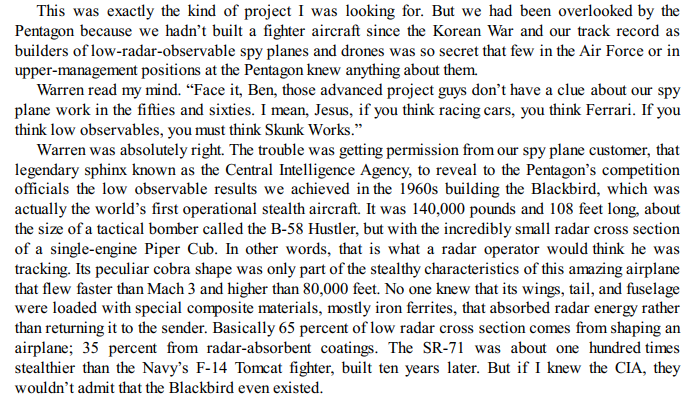
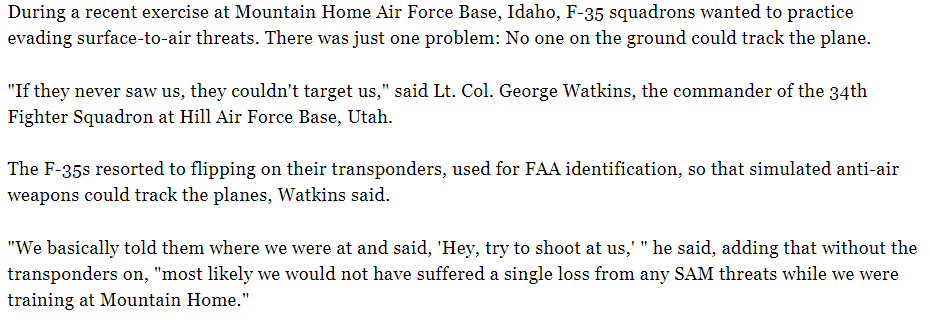
Wait a second, Have they ever mention the RAM and the RCS of F-22, F-35 and F-117 in the same document?Of course this is not from the air defense documents. In air defense, RAM are not needed, they need a ready-made figure. This is from the work of TsAGI (an institute that deals with aerodynamics and electrodynamics, including in the interests of the Ministry of Defense). To evaluate the S-shaped air intakes, they took this material.
Firstly, a black body in physic mean a body that absorb 100% energy at all frequency, it is very different from RAM designed to absorb radar energy at a narrow frequency range. In theory, you can make a Salisbury screen with 100% absorption at very narrow frequency, angle. You make a Salisbury screen by placing a thin sheet with same wave impendence as air (377 ohms/sq resistance) on top which allow radio wave to entered the RAM structure without being reflected back right at the surface, the sheet transform the short circuit at the back material into open circuit at the sheet, when the impendence of the sheet is 377 ohms/sq there is no reflection because load is matched. Yes, I know Salisbury isn't used on airplane typically because of the bulkiness and narrow band, but I just thought it is interesting to mentionAs we know from physics, there is no absolutely black body. Something is always reflected. RAM also reflects. The second graph shows reflection / absorption versus incidence angle. That is, the absorption is maximum when the wave is incident perpendicularly (parallel polarization is a broken line).
With perpendicular polarization, the maximum absorption will be at 40-45 degrees.
Well, give another scan time, thereby prove that this is a surveillance radar.My point is simple: you basically said no one would want a big X-band because scan time is too long, so I showed you an X-band with massive aperture
Same. Can you provide the correct information? No! Then there is nothing to discuss. I am not interested in guesses.How is my data not correct? I gave you the correct aperture area and correct number of T/R modules.
You said yourself in earlier post that SBX aperture isn't fully filled, so I don't understand why you make some calculation assuming it is filled?
This average comes from the radars I know.Where did you get the "0.01-0.04 seconds" value from?
This is the only value you got by cheating. Reducing the time by 10 times.About 13 -20 seconds isn't really long scan time.
Are you sure that this is the data of those years. HAWK has been modernized more than once. If my memory serves me correctly.This is set up of HAWK
AN/MPQ-50 can track target 3 m2 target from 104 km and 1 m2 from 79 km. So if RCS of F-117 is 0.1 m2, then it should be detected from 44 km.
I do not know the of these objects. neither D-21 nor SR-71I know you would say that,but they didn't compared that with bomber of the time
Similar thing with F-35 recently
I do not have such a document. You have not read my messages correctly.Wait a second, Have they ever mention the RAM and the RCS of F-22, F-35 and F-117 in the same document?
Fundamentals of physics are not interesting to me. Will RAM comparisons be from you?Firstly, a black body in physic mean a body that absorb 100% energy at all frequency, it is very different from RAM designed to absorb radar energy at a narrow frequency range. In theory, you can make a Salisbury screen with 100% absorption at very narrow frequency, angle. You make a Salisbury screen by placing a thin sheet with same wave impendence as air (377 ohms/sq resistance) on top which allow radio wave to entered the RAM structure without being reflected back right at the surface, the sheet transform the short circuit at the back material into open circuit at the sheet, when the impendence of the sheet is 377 ohms/sq there is no reflection because load is matched. Yes, I know Salisbury isn't used on airplane typically because of the bulkiness and narrow band, but I just thought it is interesting to mention
Why do you come up with something that is not. The second diagram shows the signal attenuation versus the angle of incidence. With a perpendicular incidence, with a perpendicular polarization, the absorption will be 17 dB. That is, the reflected signal will be -17 dB. Which is shown in the graph. All! And there is no need to invent anything superfluous.Secondly, the second chart isn't about absorption, it is sort of reflection coefficient.
Quite the contradiction there buddy, considering both sources are from two days ago.they don't want to ruin S-400 market success.
